
| Previous |
Next |
Malo e lelei (Hello),
We are in the Kingdom of Tonga, the key word being Kingdom.
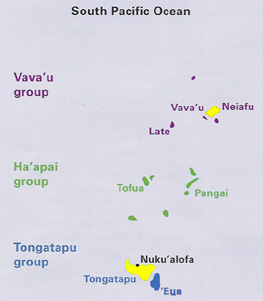
Q: You have been giving us history, geography, and geology information on many island nations now. What makes Tonga different?
A: Good question (if I say so myself!). Tonga is distinct in several ways. One is its dense population. Tonga is a group of 170 (only 42 inhabited) islands to the south of Samoa and to the east of Fiji. The total land mass is only about 690 square km but covers over 700,000 sq km of ocean. There are over 150 people per square km; that is the highest in the South Pacific. It is one of the few nations in the world to have never been under foreign rule (a group that includes Japan, Thailand, and Nepal among others). It is the oldest and only remaining South Pacific monarchy.
Tonga straddles the International Date Line. The saying goes "If it is Sunday in Samoa, it is Monday with the Monarch". So it bills itself the first country to greet the new day (or year or millennium). However, the country really has not made it into the 21st century.
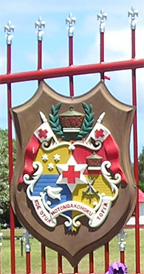
Q: How has having a king affected Tonga?
A: Tonga is supposed to be a constitutional monarchy; however, the guidebook calls it a "monarchy with a constitution". The king has absolute power. In the 30 member Parliament, the people elect only nine. The rest are appointed by the king or inherit the title as nobles. The king can dissolve parliament, dismiss members, veto legislation, and change laws as he pleases. The old king died just a few months ago, so houses and buildings throughout the kingdom are draped in black and purple bunting. Nobles are wearing special mats (see below). The mourning continues until after Christmas.
The old king ruled with a conservative, iron hand. He has shut down newspapers and radio stations that were critical of the royal family. He sold exclusive rights to the DNA of the Tongan people to an Australian biotech company without approval of the people themselves. (This deal was later stopped due to much controversy). When a competitor to the Crown Prince's airline became successful, he passed a law allowing only one domestic airline in Tonga. The royal family is well known for earning vast amounts of money (they own the airline, the main source of cigarettes, most of the telecommunication businesses) and for losing money on shaky financial schemes. Little gets back to the people. As a result, the foreign aid flows in from countries like Canada, the EU, and Australia, with a large amount from the Mormon Church in Utah.
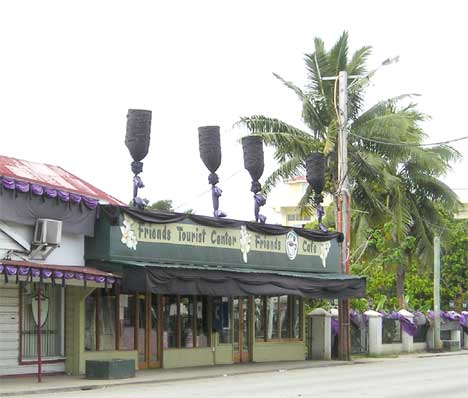
The royal family, nobles and government together own 45% of the land (much of it the prime locations). Some of this land is leased to the common folk but over 10,000 Tongans are still landless. It is the same old story: the rich get richer and the poor get poorer. There is some hope that the newly crowned king will change the system but people are restless.
Q: We heard on the news that there was rioting recently in Tonga. What happened?
A: The Prime Minister had promised that democratic reforms would be put into place before the end of the Parliament session. When Parliament closed, the reforms were not yet considered. A peaceful demonstration started in Tonga's capital city, Nukualofa on Tongatapu Island. Soon people were looting the businesses owned by the Prime Minister and royal family. Drunk on looted beer, the crowd set part of the downtown on fire, destroying the main supermarket, a bank, and other businesses, killing six people. Days later, there is still no power on that island. It is difficult to get current information and access to the Internet is limited.
We stayed within walking distance of downtown Nukualofa, leaving 48 hours before the riots. We left for the island of Vavau with plans to return to Tongatapu Island a week later for a few days at a beach resort. When we heard about the rioting, we changed our plans. So, except for a few hours stay at the Tongatapu airport (now powered by generators and far away from the riot area), we are staying longer on Vavau and heading straight for Fiji. Vavau is quiet and much more of a tourist/yachtie island than Tongatapu. Although, last Friday night they turned the power off all over the island from 10 p.m. to 7 a.m. The police cruised the town on Saturday, breaking up any groups of people they saw hanging around. It is almost like an unannounced curfew. However, we do feel very safe here.
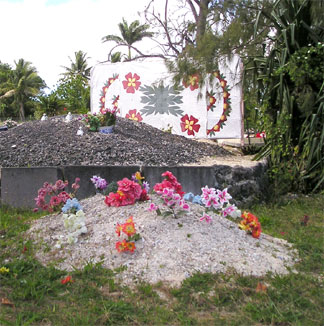
Q: What are the people like?
A: The Tongans are similar to the Samoans in that they are very religious. The only places open on Sundays are churches and a few restaurants in resorts. Tongans are very generous. When we went to get gas for a scooter, they offered us a slice of watermelon. When Tim went to buy six eggs, they gave him an extra one. All children learn English in school and everyone we met speaks some English, if only to tell us a price and "thank you". The signs and official forms are in Tongan and English.
Unlike the Samoans, burials take place in traditional cemeteries. Many of the gravesites have large hand made quilts hanging over them with the person's name and beautiful designs. Some of the graves are decorated by levels of black and white coral pieces, separated by buried upside down green beer bottles. Solar-powered patio lights surround others. This may sound strange to us, but in this poor nation, the care taken of these places and the respect for departed relatives is obvious.
Like the Samoans, the older men and schoolboys wear a wrap-around skirt but here it is called a tupenu. Older women wear dresses and skirts. Kids wear everything, but you never see short-shorts, midriffs, or beachwear on the streets. What makes Tonga clothing unique is the wearing of woven mats called taovola of pandanus fiber. They look like large woven placemats and are about the length of an apron. The taovola are wrapped completely around the hips and tied with a fiber belt, worn over street clothing. The size and style of the taovola are very important in the culture. Some people wear them daily. We have seen teenagers in jeans and taovola. However, if a close relative or the king dies (and you are a noble), you show respect by wearing huge rather inflexible mats that go from shoulders to knees. I do not know how people walk in them. Women sometimes wear dangling strips of fiber instead of the mat, which looks like a fancy grass skirt without much grass.
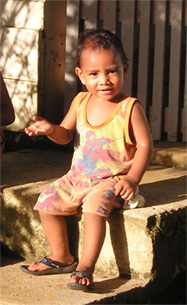
Some aspects of Western culture are readily available. Although there are no American fast food chains, ACE hardware stores have a strong presence. Television channels include the BBC and a station from China (in English). Video stores are everywhere. A few years ago, it was considered taboo for a brother and sister to be in the same room when watching a mildly suggestive movie scene. Even now, a woman would not sit in the front of a taxi next to an unrelated male taxi driver and there are no public displays of affection (except with children). However, the mass media has changed Tongan culture. A German businessman living here for 15 years said, "They are like children. They see the Western way of living in the movies and want that. However, they have no idea what it takes to earn that kind of lifestyle." Or, how unrealistic the movies can be.
We are not sure we agree with the German about the child-like qualities. For example, the Tongan language vocabulary does not lend itself to discussing business, technology, and other Western concepts. Therefore, English has to be used to facilitate conversations about these topics. In the same way, the Tongan culture is centuries old but does not easily absorb Western culture. We have seen this clash of cultures throughout the South Pacific.
Sometimes the transition can be quite humorous. Down the street is a combination café/internet access/ boat rental/laundry shop. There is also a taxi/rental car/curry takeout stand.
Q: What about food?
A: Tonga has good soil and lots of flat land making it ideal for raising fruits and vegetables, vanilla, coffee, cattle, chickens, and pigs. I mean, lots of pigs. They wander free (but belong to someone). Running over a pig on the road means big trouble here, as they may be the prize possession of a poor family. All the pigs will end up on a spit or buried in an umu oven underground as part of a traditional feast.
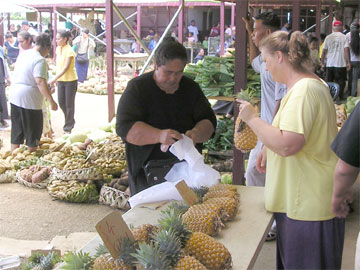
The outdoor markets are brimming with familiar things. Pineapples are six small ones for $2.50 U.S. They have great tomatoes, cucumbers, lettuce, papayas, bananas, and sweet potatoes that are white, not orange. The eggs are huge, usually with brown shells and dark yellow yolks. You buy them individually for about 25 U.S. cents apiece and you carry them home (carefully) all together in a plastic bag. They are never refrigerated, even in the stores. So far, we have had no digestive problems with them. At night, most vendors leave their piles of food out on display. Anyone could come by to steal it, but no one does.
In restaurants, you can get the usual fish and chips (with freshly caught fish), burgers (with fried egg and beets on top) and chicken sandwiches. The sauce on sandwiches is listed as "tausandiland dressing" (1,000 island). They have Coke, Sprite and local beer (brewery owned by the king). We have been eating more salads here since we could not get veggies easily in Samoa. In every country, we try to have one special meal of local foods. Since lobsters are readily available here, it was a no brainer. Lobster thermidor for about $20 U.S. sure balances out those ramen noodle dinners we have made.
We are staying in hostels and an occasional apartment, so we are getting used to limited kitchen equipment. For example, there is no such thing as a sharp knife for cutting veggies. All frying pans have permanent burned areas on them. There are no intact Teflon pans. Peelers are rare. Can openers usually do not work. This is because the equipment is used by lots of folks, many being young people who do not normally cook. Some seem to think that when the black smoke rises from the pan, the food must be ready. We have finally learned to bring a knife, peeler, and can opener with us. It is a good thing that Coca-cola has a pop-top!
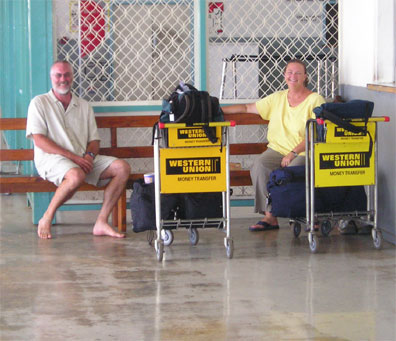
Q: Has it been easy to travel?
A: Yes and no. Most of our plane and accommodation reservations were made months ago with Tim doing last minute confirmations as we go along. The first real concern has been in Tonga. When we arrived here, we knew the Tongan Airlines had a reputation for bumping people last minute from their flights if, for example, one of the royal second cousins wanted that flight. An American living here told us to make sure the airline had our local phone number so they could call us about changes. We did and they did, moving our flight two and a half hours earlier (to 6:30 a.m.) for no particular reason. Since we have been on Vavau Island, we stop off at the travel agent every few days to see if there will be changes again. During the riots at Nukualofa, the office of the prince's airline burned. The Indian partner in the business got in the airline's only plane and left. A lot of people were scurrying around trying to get another flight or get money back. (Luckily, we were booked on a non-Tongan airline).
On many of the islands we visited, car ownership is not common. A village might have one person with a car (usually the minister). Remember that all cars need to be shipped by boat. So often, a local buys a used car, usually from Hawaii or New Zealand. Rental cars might just be someone's personal car they did not need that day. Taxis are numerous. Some have signs, some are just friends called to take visitors to the airport. Most have those perfumed cardboard cutouts hanging from the rear view mirror. You always need to agree on a price before you start as no fees are posted and there are no meters in the taxi. And the price of a trip is not always related to distance traveled. Taxis are officially not available on Sundays, but the hostels all know someone with a car.
Q: What have you been doing?
A: In Tonga, we stayed on the two largest islands.
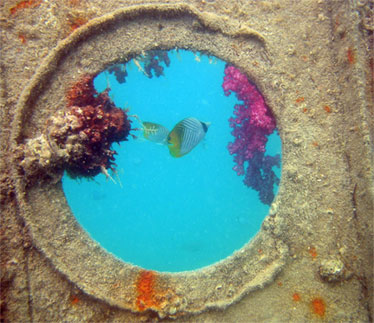
Tongatapu: The apartment we stayed at here was huge (compared to our usual hostel rooms) with free wireless internet. We never expected that. We would walk into town to buy groceries (at the store that later burned down), checking out the souvenir shops and local markets. On Sunday, swimming is restricted to resorts only so we hopped on a ferry for a 12-minute ride to Pangaimotu. This small island had a half-submerged boat wreck that made for great snorkeling and a small resort for snacks. We were told that some Sundays, the island is packed with visitors and locals alike looking to cool off on the day that nothing else is open.
In a rental car (actually, an entrepreneur's personal car), we went around the island seeing some historical sites. One was a trilithon; two huge upright rocks with a third rock fitted to the top each weighing 40 imperial tonnes. This giant archway is dated to about 1200 A.D. and has been shown to align with the sun during the winter and summer solstices, just like Stonehenge in England. There were also ancient burial structures, some with curved fitted stones (1500 A.D), the biggest in the South Pacific. We sometimes forget that the cultures here date back to 1000 B.C. It is also fascinating to see how cultures can develop similar monuments, like the trilithon and Stonehenge or the Tongan burial structures and the Egyptian Pyramids.
We have traveled out of our way to see a single blowhole in many areas of the world, but the southern shore of Tongatapu was unbelievable. For as far as you could see, the sea would shoot up geysers of water 30 feet high or higher through natural holes in the coral. Instead of the usual one or two blowholes, there were five solid kilometers of them! Their roaring sound made it impossible to talk! Tim was able to take lots of photos with the water shooting up. This is not easy when there is only one blowhole around.

We have complained about lack of signage in the past, but in Tonga there are no street signs anywhere once you get out of town. This situation, combined with inaccurate maps in the guidebooks and from the Tourist Bureau, makes finding those "must see" tourist sites a real adventure. Several times, we would have to stop, stick our map out the car window at a local and say, "Please, where are we?" We drove past the huge trilithon twice even though it was right at the side of the road as we were trying to figure out what village we were in (no signs for that either). In searching for "Tonga's most famous cave", we drove up and down every unpaved road in a village, some of them twice, as that is what the map showed. Di even walked as far as five feet before the cave entrance (unsigned) and back out without finding the cave. Finally, we followed a local guide who was showing someone else the cave entrance (this guy owned our rental car). Of course, after all this, we forgot to bring our flashlights so we could not see much of the cave anyway.
Vavau: This island is quite a contrast to Tongatapu. The safe harbor makes it popular with yacht owners (yachties). The visiting humpback whales make it popular with tourists, but the whales had moved on by the time we got here. The main town, Neiafu, when viewed via kayak from the water, looks it is thriving, with an active harbor, anchored yachts, and waterside restaurants. When you arrive by car, your perception is different. Neiafu is about three blocks long and kind of depressed looking with a couple of groceries, various service shops, and bars. However, we quickly found a great local Austrian bakery, a Tongan buffet cooked by a Swiss chef, and a source of New Zealand ice cream so the yachties and tourists have some influence here. Visits to the nearby fruit/veggie market became an almost daily ritual.
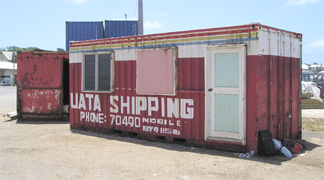
Something we noticed throughout the South Pacific is the large shipping containers found at both the harbor and next to houses all around the islands. If it is not grown on the island, it must be shipped in. This includes everything from bricks to cars to food to disposable diapers to fan belts to plastic washtubs to visiting family members (cheap fares). So people would keep a container to fill with goods or send back to be filled with necessities. One day, seeing lots of activity at the harbor, we walked down to watch the unloading/loading of a cargo ship from Nukualofa. Scores of people and vehicles here. This made us realize how spoiled we are. A trip to Meijers or shopping on the Internet can get us almost anything we want in a few days at most. Here, you need to plan ahead and a broken window may not have a replacement for months. Life here is simpler by necessity.
There are no nearby beaches to the town so we traveled by taxi then by dinghy to a very small resort island, Mala, to snorkel. There were plenty of coral beds to see but the current and waves made the snorkeling difficult. So we read on the beach, walked around the island, and had lunch at the resort. We were the only ones there, except for the manager's family as it is off-season. It was still a great day.
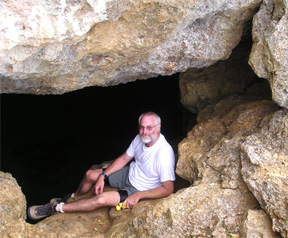
We also went in pursuit of another famous cave, this one with a fresh water lake. We walked quite a distance, again asking for directions. We did remember our flashlights this time. However, the lake was quite a drop down coral rock and looked inaccessible to us. The local kids may go for a swim, but I am not sure if Tim got down in the little lake, how he would be able to climb up. I think we will need to investigate the next "famous cave" on paper, before we head out!
Sundays in Tonga (and Samoa) are quiet. You either hang out all day reading or head out of town for a beach where it is permissible to swim. Di decided to attend the local Catholic church. Although it was entirely in Tongan (except for the Gospel), you can still tell what is being said since all Catholic church services (masses) are essentially the same worldwide. The guidebooks talk positively of the church singing. Wow! Accompanied only by an unamplified piano, the choir (sitting on one side of the church) sang hymns very loudly in wonderful four-part harmony. As the voices carried through the large but simple church, you could close your eyes and think you were in a cathedral. There were lots of little babies and children but no crying. When a baby started to fuss, the woman holding the baby would get up and give the baby to someone else (a relative, I assume). Sometimes she would walk across the church to deliver the little one. This happened all through the service and no one seemed to mind. So, I guess it does take a village to raise a child!
Sunday evening we went to the "movies" in the ballroom of a local hotel. This consisted of a curtain on which the DVD was projected via computer, but not bad for $2.50 U.S. each. We all (American and German tourists and ex-pats) sat on couches watching Al Gore's documentary, "An Inconvenient Truth" about global warming.
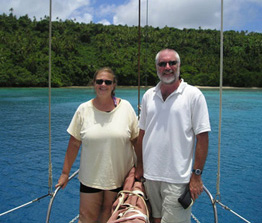 We urge all of you to see this very well done and interesting film. It is ironic that we had to come all the way to Tonga to catch up with it.
We urge all of you to see this very well done and interesting film. It is ironic that we had to come all the way to Tonga to catch up with it.
During the last few days, we have been trying to work in at least one more snorkeling activity around the wind, clouds and (just recently) sudden downpours. On our last day in Tonga, we (and three other tourists) took a sailboat to a distant island to snorkel (see attached). The skipper and crew did the work as we slowly scooted around the islands and back. It was pretty good snorkeling and beautiful, but sailing is a lot of work with little room for error. We have both had some bad sailing experiences, but having a competent skipper makes a difference (so does Dramamine). The trip was not enough to change our mind about buying a boat, but it was a unique way for us to travel and see Vavau.
We are on our way to the Yasawa Islands in Fiji, then Hawaii, then home. Hope you all have a wonderful Thanksgiving weekend with family and friends, counting your blessings.
Malo aupito (thank you very much) and Alua a (good bye).
Di & Tim
| Page Top |
Map |
Itinerary |
Previous |
Next |
| Tim and Diane's email address is ttdk@comcast.net | ||||